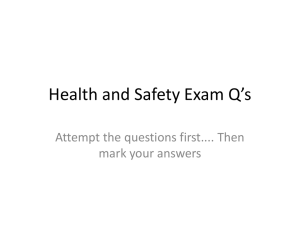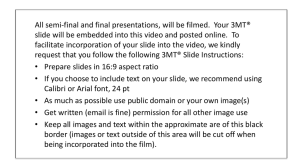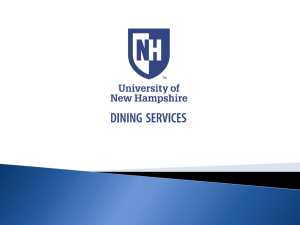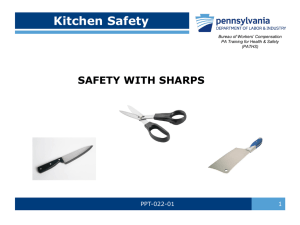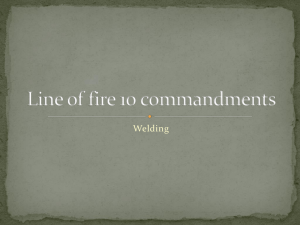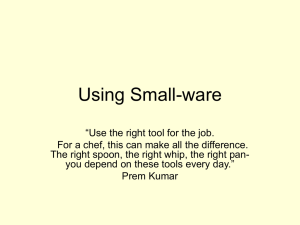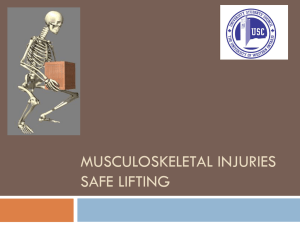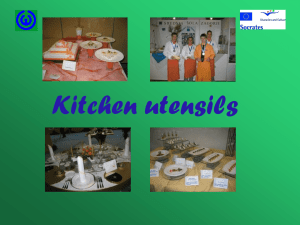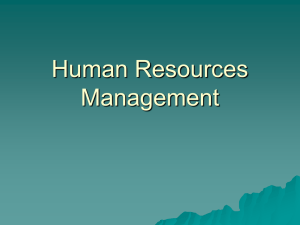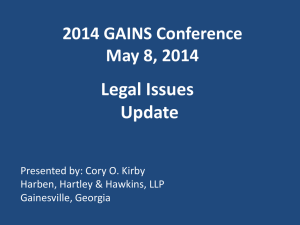PPT - Safety and Environmental Management
advertisement
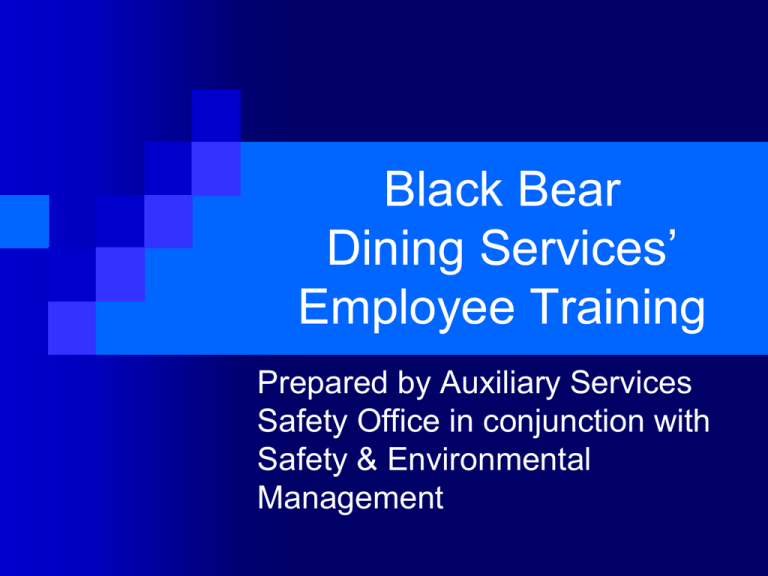
Black Bear Dining Services’ Employee Training Prepared by Auxiliary Services Safety Office in conjunction with Safety & Environmental Management Overview Policies Employee Rights Employee Responsibilities Accident Reporting Violence in the Workplace Signs and Labels Kitchen Hazards Student Dining Employee Training Welcome to Black Bear Dining! This is a fun, fast paced working environment As a new employee, you need to be prepared to learn new jobs, recognize hazards and work safely Remember, when in doubt, ask your supervisor! Policies to Follow This training program is designed to provide you with an introduction to UMaine, state and federal policies and procedures necessary to provide a safe and productive workplace Black Bear Dining management team wants you to enjoy your job. They need your help to maintain a safe, clean and productive environment for all employees What Every Black Bear Dining Employee Should Know – Your Rights You have the right to a safe workplace free of serious hazards stop work and contact your supervisor when serious hazards are recognized information to protect you from the hazards that cannot be eliminated classroom or on-the-job training medical treatment if you are injured on the job access occupational medical and exposure records What Every Black Bear Dining Employee Should Know (continued) Responsibilities You have the responsibility to work safely and report unsafe conditions to your supervisor follow UMaine policies and procedures participate in all training notify your supervisor immediately of any injuries or near misses What Would You Do? As a new member of Black Bear Dining Services, it is your task to run the fryolator. Your supervisor asks you to put in a fresh batch of French fries while they tend to something else. You realize you were never trained to use the fryolator and do not know when to add the fries. Do you A. B. C. D. Add the frozen fries to the oil once it is boiling Find your supervisor and learn the proper technique Ask a co-worker Add the fries and then wait for the oil to boil Answer B: If you are not trained to Safely perform a task, make sure you inform your supervisor. They might not know you did not receive the proper training. What Would You Do? Bobby, a Black Bear Dining employee didn’t have enough time to do prep work before the dinner rush came in. Working quickly, trying to dice some vegetables, Bobby cut his hand. This could have been avoided by A. B. C. D. Wearing a cutting glove or using a finger guard Being more attentive with the given task Making sure the counter is at a comfortable height All of the above Answer D: All are effective ways at preventing knife injuries. Being properly trained is also a requirement. Kitchen Hazards The key is to recognize hazards and take action Common details to be aware of -slip, trip & fall hazards -sharp objects -burns & hot pans -knife cuts -over reaching -clutter & lack of proper labeling -swinging doors or sliding doors -self awareness & awareness of others -improper use of chemicals -strains & sprains -repetitive motion Remember to use proper cooking mitts or other appropriate tools for safe cooking tasks What is the most frequent top 5 injuries from this list? Top 5 Common Injuries Slip, trip and fall hazards are caused by grease or water on the floor objects obstructing walking paths Burns are caused by hot water fryer grease hot pans or steam Cuts are caused by sharp knives or other objects packaging Strains and sprains are caused by over-reaching heavy lifting Repetitive motion can cause injuries using the same muscles without proper equipment (that normally show up later in life) Accident Reporting To contact emergency personnel dial 911 or on a cell phone 581-4040. Contact your supervisor If you encounter what you suspect to be blood or other bodily fluids contact your supervisor. DO NOT attempt to clean up bodily fluids. Others who are trained in basic blood borne containment will attend to clean up. They are supervisors custodial teams Injuries and Reporting If you experience a small cut, bruise or abrasion use the First Aid Kit in your work area ask a fellow employee for assistance if you cannot attend to the injury yourself Inform your supervisor of all minor injuries Emergency Action Plan An Emergency Action Plan (EAP) describes the hazards present within a work area and the actions necessary for the safe, prompt & complete evacuation of employees, students & guests. You need to know where the emergency exits are located for your work area how to report an emergency where your Emergency Action Plan is located where Rally Points are located outside (of the building) know whom the dining staff authorized to stay behind to check the area Violence in the Workplace Definitions Physical Attack acts of aggression, assault or homicide Emotional Attack threats of violence, verbal abuse or excessive kidding, taunting, intimidation or stalking Violence in the Workplace (Continued) Black Bear Dining maintains a safe and comfortable place for all employees. It is important to recognize and react quickly to violence in the workplace. You can help by notifying your supervisor immediately if you have a problem notifying the Office of Equal Opportunity if you are uncomfortable talking to your supervisor Contact EEO at 581-1226 Black Bear Dining is a safe & fun place to work and often provides students with an opportunity to obtain their first job. Signs and Labels Chemicals (cleaning supplies) Food labels OSHA signs and labels Realize warnings or potential hazards What’s wrong with this picture? The chemical labels are unclear The workspace is messy Do you see anything else wrong? Hygiene You can practice good hygiene by Washing hands frequently Trimming finger nails Covering cuts and wounds properly Changing bandages frequently Using antibiotic ointment Wearing proper hair restraint Wearing proper foot ware Dressing accordingly (no loose clothing or jewelry) Following H1N1 protocol as directed by the University of Maine Knives As food service workers you should Always have knife training before using a knife Cut on a flat and proper surface Cut away from your body using cutting gloves and/or finger guards Clean knife at a wash sink closest to your work station and immediately return it to its storage area. Wash, rinse, sanitize and put away in the knife rack. Knives (continued) Walk with the knife pointed to the floor close to the body Place knife on the table if you must pass it to another employee Remember to properly put away and store knives after use Point cutting edge away from your hands when wiping down knives Lay knives flat and away from counter edge Receive on-the-job training prior to using knives Falls & Spills Clean up spills immediately Use wet floor signs when mopping Close drawers and cabinets Use sturdy ladder on a flat surface when obtaining Supplies from high shelves. Burn Prevention Guidelines Never leave pan handles over burners Make sure hot dishes are out of the way of others What is wrong with the picture below? Turn burners off after use Always use pot holders or oven mitts Tell your supervisor if there are not any pot holders or oven mitts in your area Use appropriate pathways in the kitchen Burn Prevention Guidelines (continued) Do not use the kitchen areas as shortcuts If passing behind someone in a kitchen let them know. Get proper training if using a steamer. Never pour water on a pan fire that contains grease Notify person cleaning pots if a pan is hot. Keep flammable materials away from ranges and stoves Do not put combustible objects (for example - napkins or towels) near the stove or open flames Dish Room Safety Keep walkways & work area free of clutter Keep slip resistant floor mats in place and keep clean Wear appropriate waterproof non-slip footwear Cool dishes and glasses before unloading from dishwasher Avoid steam – it can cause severe burns Open hot water faucets slowly to avoid splashes Dish Room Safety (Continued) Maintain kitchen hot water at or above 130º F if sanitizing with chemicals Arrange work spaces so it is easier to reach for routine supplies This will prevent over reaching and awkward back, shoulder and wrist postures Test water temperature in sink before sticking your hands into the water Spot mop only during busy times Wipe up spills immediately This is what a clean, dry work area should look like Dish Room Safety (Continued) Use care when using soaps, detergents, drain cleaners and other solutions & sprays These can cause skin and eye burns or irritations Be sure you are properly trained in the use of personal protective equipment Slipping and Burns are the most common dish room safety related injuries, how can they be avoided? A. By making sure your work area is dry B. Using less water C. Avoiding steam and splashing of hot water D. Both A and C Answer D: These are just two ways dish room injuries can be avoided. What others can you think of? Real Case Scenarios The knife somehow slipped from the hand and cut the right index finger Contributing Factors The employee was not wearing cut resistant gloves The employee was inattentive The employee did not have knife safety training Corrective Actions Wear cut resistant gloves Get knife training prior to using a knife. Concentrate on the work task rather than distractions and conversations with others while cutting. Look for options to reduce risk of knife cuts Remember You have the right to a safe work environment If ever in doubt just ask a supervisor This should be a fun learning experience, please don’t let an injury get in the way If you have any questions about this training program please contact 581-4483. Please click on the back arrow and then click on the test link to finalize and document this training. Have A Safe Day Remember to Wash Your Hands and Kitchen Surfaces Thank you for completing this training
